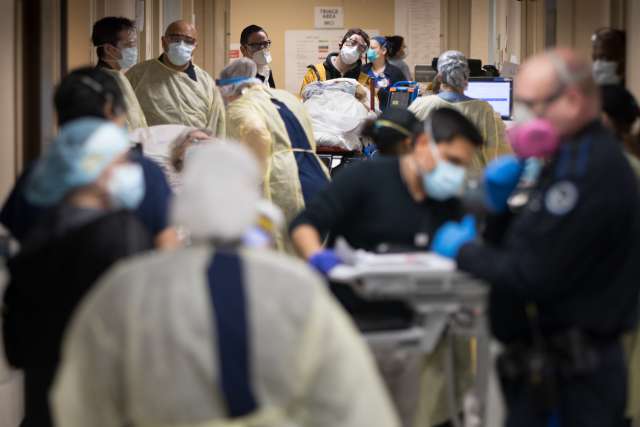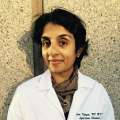This holiday, like every holiday in years past, I drive to the hospital on the quietest of days. After a day of torrential winter rain, the sleeping giants that surround Los Angeles, the verdant Santa Monica and snow-capped San Bernardino mountain ranges, rise crisply against the clear blue skies. The 405, our country’s most famous highway, is unobstructed, with few cars on the road. The surfers hang low, unable to paddle out, given the post-storm coliform counts.
There is a sacredness in this quiet, which is particularly conspicuous in the hospital during the holiday season. And still, the city of Los Angeles burns in a way it never has before.
Just nine months ago, my infectious-diseases colleagues and I had our first emergency Zoom meeting when we rapidly reassessed our triage process for the onslaught of pages we were getting on a still unknown virus. Back then, everyone mobilized, creating several layers of “back-up” physicians who would be on-call at all times. It was simply untenable for a single person to manage the constant questions of our fellow health care workers, while doing our best to allay the apprehension and the uncertainty. On more than one occasion, I would retreat to the bathroom stall to temper my own anxiety, fear and immense sorrow for all that we had already lost.
Much of our fear in March was the fear of not knowing how many people in Los Angeles were infected and if we would see the volume seen in New York City’s hospitals. The depth of New York City’s socioeconomic disparities was one that we also knew in our city and saw proof of daily. Historical redlining has perpetuated segregation well after the dissolution of Jim Crow laws. During the pandemic, study after study has shown how great a risk factor racism — with its multiple downstream effects, including overcrowding and food insecurity — is for COVID-19. Why would we not experience the same devastation in L.A.?
Somehow, the idea of truly scarce resources remained just an idea through the summer and fall. Before long, we knew most of the time who was infected, and we had a general approach for treating them. Enrollment in trials to get better data remained a priority. We held our breaths as our communities, largely masked, took to the streets, weary of centuries of racial injustice now magnified. We waited for the peak. It never came. Instead, what we saw was a steady flow of new infections. The rates had never truly ebbed.
By November, however, we began watching the county numbers steadily rise. The pleas of our public health institutions rang hollow for many as our leadership failed to set an example. Our fellow Angelenos were tired and lonely. People started to gather indoors. Pandemic shaming was backfiring. And, exactly two weeks to the date from Thanksgiving, the hospitals’ numbers started to double, then triple. Our multiple layers of back-up were simply not enough. It was, in many ways, inevitable that we would eventually approach a crisis.
The time had come to scale up in a way that U.S.-trained physicians were not used to. In less well-resourced settings around the world, much of health care is delivered by health care workers with less comparative training but who follow protocols — more prescriptive guidelines than guidance. Such guidelines, often written by ministries of health, take the tone of policy and are the only way a single person can see 60 patients with HIV a day and start them on antiretroviral therapy. This is how pandemics are managed during periods of peak crisis and scarce resources. We now resort to this in our own previously well-resourced hospital systems.
By early December, we began to restrategize. In an effort to decentralize teams, moving from “COVID teams” to “teams that took care of patients with COVID-19 and others,” we created a two-hour Zoom session on COVID-19 management for more than 70 inpatient health care professionals. When it came to remdesivir, the only FDA-approved COVID-19 treatment, we acknowledged that our national guidance often differs from that of the World Health Organization, based on resources and priorities. Remdesivir’s benefit is a reduction in time-to-clinical improvement, not a reduction in mortality, and many U.S. hospitals are willing to pay the $3,120 per five-day course to get patients discharged sooner, saving costs and resources downstream. Low-cost dexamethasone, which has had modest evidence demonstrating a mortality reduction, was also an important treatment to consider for those with progressive hypoxia. We made it clear that any other treatment remained experimental.
With time, the desire to do something new and different has softened as frontline physicians quietly take on patient after patient. On occasion, the desperation surfaces, as we watch hospitals to the east of us take care of patients in gift shops. Unproven therapies for COVID-19, such as ivermectin and fluvoxamine, are promoted by some and find their ways into the histories of hospitalized patients, sometimes resulting in critical shortages for their intended use. Less-proven therapies such as monoclonal antibodies offer modest hope to prevent hospitalizations, but with limited space and staffing to administer this treatment, it remains a scarce resource that we try to deliver equitably.
This holiday season, like every holiday season before, I drive to the hospital on the quietest and clearest of days, eyes fixed on the jutting mountain ranges that surround our beloved city. This city — complex in demography and geography, and exposed by its measures of social vulnerability — is burning in a way that feels slower than New York. Los Angeles, in the wake of profound pandemic fatigue and the fallout from highly politicized public health interventions, will burn slow and long. And while case-fatality rates have dropped, in part due to improved care, many in our community, young and old, will still die.
This remains the hardest pill to swallow. The inability to see loved ones at the time of their suffering and their death remains a painful experience that we, in health care, live vicariously through our patients and their family members. It is what we fear the most as the personal radius of those who have COVID-19 grows smaller.
But I remain hopeful. I am hopeful for the power of masking, the power of vaccines and the power of compassionate positive messaging. After all, in this city of dreams, in this City of Angels, what are we without hope.

